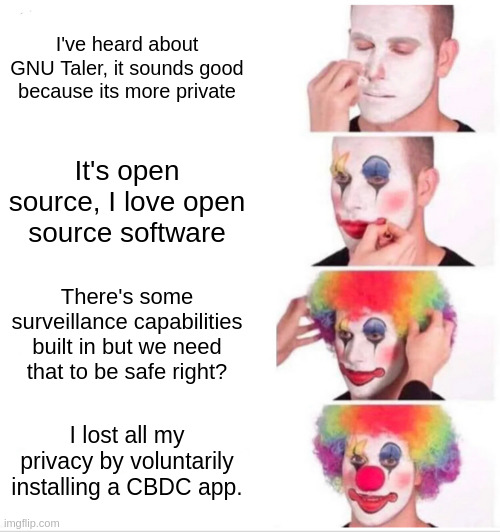On P2P payments from their FAQ: “While the payment appears to be directly between wallets, technically the operation is intermediated by the payment service provider which will typically be legally required to identify the recipient of the funds before allowing the transaction to complete.”
How about, no? How about me paying €50 to my friend for fixing my bike doesn’t need to be intermediated, KYCed, and blocked if they don’t approve of it or know who the recipient is? How about it’s none of the government’s business how I split the bill at dinner with friends? This level of surveillance is madness, especially coming from an app that touts “privacy” as a feature.
GNU Taler is a trojan horse to enable CBDC adoption. They are the friendly face to an absolutely terrifying level of government control in our lives funded by the same government that tries every year to implement chat control. Imagine your least favourite political party gaining power. Now imagine they can see and control every transaction you make. No thanks.
A place to discuss privacy and freedom in the digital world.
Privacy has become a very important issue in modern society, with companies and governments constantly abusing their power, more and more people are waking up to the importance of digital privacy.
In this community everyone is welcome to post links and discuss topics related to privacy.
Some Rules
- Posting a link to a website containing tracking isn’t great, if contents of the website are behind a paywall maybe copy them into the post
- Don’t promote proprietary software
- Try to keep things on topic
- If you have a question, please try searching for previous discussions, maybe it has already been answered
- Reposts are fine, but should have at least a couple of weeks in between so that the post can reach a new audience
- Be nice :)
Related communities
much thanks to @gary_host_laptop for the logo design :)
- 0 users online
- 108 users / day
- 435 users / week
- 1.32K users / month
- 4.54K users / 6 months
- 1 subscriber
- 4.55K Posts
- 115K Comments
- Modlog







That’s a cop-out to avoid discussing that none of the stable coins have anywhere close to the assets they claim to have and which would be necessary to peg the value.
You can examine the MakerDAO contract, for example, and see all of the assets they claim to have sitting right there under its control on the blockchain. You can see the contract logic behind how those assets enter and exit its control.
If you can’t see how the snake bites its own tail here I can’t really help you, but on-chain “assets” do nothing for a stable coin that needs to be secured by off-chain assets.
So basically you only “believe in” off-chain assets? That’s fine, but it kind of removes you from any discussion of the details of blockchains. You’ve rejected their entire premise so why bother?
No, I am rejecting the notion of stable coins, which are by their own definition literal scams. But I am strongly suspecting that you are directly involved in such scams as you continue to muddle it with entirely unrelated issues just so to make it sound like this is a general problem and not a stable coin specific one.
By what definition is that?
That they can peg them to a currency like the USD. Unless you are the United States of America, that is literally impossible. But even if you discard that technical impossibility, none have even close to the assets required to even approximate a peg, so it is a scam both theoretically and practically.
Here’s DAI’s peg over time. Over the past year it’s had a high point of $1.0012 and a low of $0.9979, neither extreme lasting more than a brief spike. Seems like a pretty good peg to me. The mechanism by which it maintains its peg is complex, but fully transparent since it happens entirely on-chain.
Here’s LUSD, another similarly algorithmically-pegged stabletoken. It’s smaller than DAI so it’s a bit less stable, it had one spike this year where it went all the way up to $1.029. But the mechanism is much simpler so if you’re having trouble understanding DAI it might be an easier place to start.
I have no problem understanding that scams need to look good for a while to attract victims…